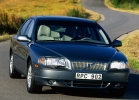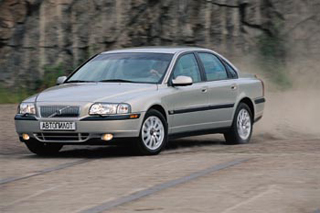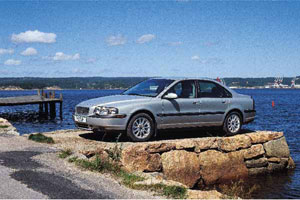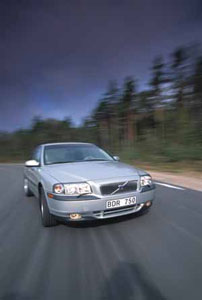Test drive Volvo S80 1998 - 2003 sedan
Diesel expansion
The life principle of either everything, or nothing very often can be applied to the organization of tests, the results of which you read almost weekly in our newspaper. Getting a car for a test, and even more so a new model, and even quite expensive, in most cases it is incredibly difficult, and even if such a test happens, often it passes under the motto step to the left ... but sometimes, it is a pity that very rarely, There are pleasant exceptions to this rule. So it was in this case. The official Volvo dealer in the territory of the Republic of Belarus, Elitavto, on the eve of the opening of a new car dealership, which will present almost the entire spectrum of Volvo models delivered to our market, provided two cars for the test of S40 and S80 with turbodiesel engines at once.In fact, the S40 model appeared back in 1996, and the eighties are also already in production for more than a year, so it is wrong to represent them as new items, to put it mildly. Moreover, no further, as this fall, S40 was subjected to thorough restyling, which touched mainly mechanical filling, and we still had a prerestylal version on the test. However, given the fact that diesel versions of the cars of this brand officially did not supply us until this year, and the usual S40 and S80 in the automobile press practically did not flash here, it was very interesting for us to test these machines.
In the mid -eighties and early nineties, Volvo diesel modifications were very popular, and judging by the proposal of used cars, their share in the production range at that time was almost half of all Volvo cars manufactured. But then the company so zealously took up the formation of a new image of the Driver car that diesel versions for some time fell out of sight of potential buyers, pushed out by magnificent, truly cult, prestigious sports models of the T-5 and R series. I must say, they achieved their own And the phrase, accidentally thrown in the circle of acquaintances, I go to the sports Volvo, now speaks not only about your well -being. However, sports expensive models have always played the role of jewelry rather, and as a rule, more mundane modifications, including diesel, are in greatest demand. But this does not mean that they are assigned the role of workhorses: the use of the latest technologies in the design of diesel engines made it possible to make from eighties, and from S40, perhaps, too, cars that can be called Driver Cars without a shadow of doubt.
Like all normal people, I wanted to get everything at once, so the first thing I went to the S80 silver color overflowing all kinds of silver color. The 2.5 woold on the trunk lid unequivocally hinted at the far from modest capabilities of the engine, and I already began to think where to ride, but the company representative suggested first trying the forty. What's the difference? - I ask. Big, - he answers evasively. Well, let's go on the growing ...
The S40 model is the smallest car that carries a Volvo label, and belongs to the middle class. Its direct competitors, not only in size, but also in price, are the BMW of the third series and Mercedes C-class. But only, unlike German automakers, no matter how tempting it looks, Volvo until, and, we hope, this will never happen, has never descended before the release of mass and inexpensive models like A-Class or Compact. A car of a prestigious brand, even if it is not the largest model, a priori should be expensive, and any experiments in this direction only lead to a drop in the image of the brand in the eyes of specialists and potential buyers.
The green color is very for the face of the S40, and the car looks even more prestigious and stricter than with a diplomat, it is not for nothing that it was made with a branded color for the prestigious sports modification of T4. By the way, as it became known, Belarusian buyers, acquiring Volvo, most often stop at T4, and they can be understood. Indeed, despite its outstanding technical characteristics, T4 is inexpensive for sports, of course, model. In addition, one should not forget that this is still Volvo. Even considering that the models of the fortieth series have been in production for about five years, it does not look outdated or, say, gleamed. The appearance, despite the similarity of all modern cars, leaves no doubt that you have Volvo. Moreover, in general, the design turned out to be very harmonious, and this is expressed at least in the fact that with a photo of the S40 at any perspective, it looks very expressive, I would even say - expensive and stylish. It is only a pity that the requirements of aerodynamics did not leave the designers the opportunity to make the car even more expressive, although, on the other hand, Volvo was never puffy - the severity of the appearance and even some of its staticity played an important role in forming the image that Volvo has today.
It so happened that I went to the S40 twice, with an interval of several days. And if for the first time all the attention was paid to the running qualities, then the second trip was more cognitive in terms of the potential owner. For example, completely unexpectedly, I found a pocket right under my feet, on the front edge of the driver's seat pillow. It seemed to me that it was most convenient to place there ... A gas gun or other self -defense gun - and there would be no way on the cabin, and at the right time it is always at hand. But this is me so, remembering the realities of our life. Let's hope that we will never need additional equipment.
As soon as I got into the Sorokoy salon, I immediately thought about the main VOLVO trump card - security. And the point is not even in air pillows, of which there are three in it, if you do not take into account inflatable curtains that protect during lateral clashes. The salon itself gives the impression of something supernight and protected - the lateral and front racks, although they are turned relative to the axis so that the review is not closed, but it is felt that they are made with a large margin of strength. And the rest - a car like a car: a large trunk, a chic leather interior. The cold turbodiesel engine gives a little characteristic vibration to the controls and even to the driver's seat. It’s not that it interfered or annoyed very much, but most modern diesel engines work a little softer. However, when we arrived at Borovaya, the temperature indicator arrow already moved to the green sector, and the vibration level decreased markedly. Moreover, during the test, we were transplanted several times from the fortieth to S80 and vice versa, and I can tell you that a small difference can only be felt at idle. But if you add to the gas, then the type of fuel that the car feeds will only be can be determined by bass ruling. However, for the start of movement, the gas pedal can not be touched - like all not very forced diesel engines, the Sorokova motor normally pulls even at idle, not only in the first, but also in second gear. True, if you need dynamic acceleration, then it is better not to lower the tachometer arrow below 2000, because from this moment a turbine comes into work, which instantly turns the process of acceleration from tedious-nudus into fascinating-minute. Almost to the very red tachometer zone, the engine pulls, if not perfectly, then on a strong four for sure, especially in third gear. But to twist it every time to the red zone on the tachometer also does not make sense-after four thousand acceleration begins to subside, so the most optimal regime is 2000-3800 rpm, which is at the highest, fifth, transmission corresponds to approximately 60-140 km/h/h/h .
Once I was very surprised to learn that the sports version of the T4 by suspension has not many differences from ordinary forties, but now everything has become in its place. It itself is relatively soft, therefore, it almost does not transmit trembling and other surprises from the road surface to the body, but the rigid reptile stabilizers make the passage of steep turns, even on the diesel version, very interesting. Moreover, on the snake, the car behaves simply amazingly, except that the empty steering wheel somewhat prevents completely feel it. But at high speed, far beyond 150 km/h, there is no need to steal in order to hold the car on a straight line.
Oh, it was not for nothing that the representative of the company was the first to recommend the forty, because the S80 is a completely different movie. Maybe I was so impressed because I jumped through one step (V70, or S60), but even in comparison with other models of this class S80, it looks just well done. The continuity of traditions is obvious - common lines are similar, but only everything is done at a different, higher level. This does not mean that the S40 is something worse, it just gives it only that, in principle, you expect, well, maybe a little more, while the eighties are simply amazing.
Of course, the difference in price obliges to be on top, but I would never have thought that the top -class turbodiesel car can be made so interesting, both in design and in running qualities. It looks eighty, as is appropriate to a higher class car, but the upper class continues in all the little things, and everything is done thoroughly and thoughtfully. Say, the trunk lid - on the outside it opens with a light touch of the touch key, but if the battery suddenly smells and the electronics does not work, then there is a keyhole on the side. But most of all, the salon, or rather, the quality of its finishes and design are striking.
While some firms manage to bring decor elements and some details unified with cheaper models, even on high -class cars, Volvo makes the main bet on the quality and originality of the interior. Everything is like in the best houses: expensive soft plastic, carbon fiber inserts, a leather interior and other pleasant excesses. The composition of the driver’s chair - the instrument panel/central console - the door panel is simply flawlessly, and the salon seemed to imprison the driver in its arms, but this is done very unobtrusively, without the characteristic of some driver's models of tightness. It will probably be difficult to cope with this car in a controlled drift, because all controls work on the principle of computer joysticks: you just show what you need, and the car will do the rest yourself.
It’s not to say that the eighties were completely insensitive - it can be put between BMW and Mercedes, slightly closer to the latter, in terms of smoothness. In combination with magnificent sound insulation, this gives rise to the effect of a home theater: a magnificent picture and muffled, as if recreated with the help of a powerful digital processor, sounds give a rather unusual feeling when driving. All superfluous remains there, overboard. It seems that click on some key, and the picture will stop, and a huge flashing inscription Paus will light up on the windshield.
There is only one way against such a glitch - to be more difficult to squeeze the gas pedal. The developers of computer simulators have not yet, thank God, have not learned to simulate overloads that occur at an active start, all the more so.
The diesel engines, especially the last generation, are famous for the magnificent traction, but almost all such models, very expensive, are placed, and, as it turned out, is very in vain. Thanks to the mechanical gearbox, the eighties turned out to be very frisky, one might even say, groovy. And it starts from the very beginning - unlike the previous car, it has practically no turboyam turbodiesel engines, so acceleration is guaranteed in the entire speed range, starting directly with idle. The thing comes to the point that if you sharply sell the pedal to the floor, the drive wheels begin to slip (this is on dry asphalt!).
Passports ten seconds to hundreds are simply lost against the backdrop of excellent acceleration and sound accompaniment, which without exaggeration can be called the average between that of the in -line six BMW and the sound of the opponent of the old Porshe 911. I can’t even believe that there is only 2.5 liters of working volume and 140 under the hood and 140 horses, let the motor are equipped with a direct fuel injection system. I did not go to the Volvo S70, which was also equipped with such a motor, but even in a heavier eight, it feels very organically. The supply of torque allows you to continue dynamic acceleration and after 160-170 km/h, but we could not accelerate faster during the test. And on the other hand, much faster, after all, we are not going to Ferrari. It is much more pleasant, choosing a favorite disk, enjoy the magnificent sound of a stereo system with the Dolby Prologick processor, overcoming dozens and hundreds of kilometers at cruising speed ...
Pavel Kozlovsky.
Video Crash tests Volvo S80 1998 - 2003
Test drives Volvo S80 1998 - 2003
Krash Test Volvo S80 1998 - 2003
Krassh Test: Detailed Information29%
Driver and passengers
14%
Pedestrians












